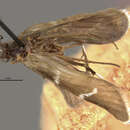Comprehensive Description
provided by Smithsonian Contributions to Zoology
Smicridea (Smicridea) nigripennis Banks
Smicridea nigripennis Banks, 1920:359.—Fischer, 1963:134.—Flint, 1967b:14.
The species was described from Cali and Caldas, Colombia and has not been reported from other localities since. These examples from Venezuela thus represent a major range extension.
There are noticeable differences in the male genitalia between examples from the two regions. The Colombian examples have the dorsal spines of the aedeagus shorter and comparatively stouter and more sharply twisted laterad in dorsal aspect. Yet the basic structure of the aedeagus and spines is identical in all this material, therefore I am calling this one species at this time.
MATERIAL.—VENEZUELA, ARAGUA: Estacion Piscicultura, 5–6 Nov 1974, 1. CARABOBO: Yuma, 12 Feb 1976, 1.
- bibliographic citation
- Flint, Oliver S., Jr. 1981. "Studies of Neotropical Caddisflies, XXVIII: The Trichoptera of the RA-o Limón Basin, Venezuela." Smithsonian Contributions to Zoology. 1-61. https://doi.org/10.5479/si.00810282.330
Comprehensive Description
provided by Smithsonian Contributions to Zoology
Smicridea (Smicridea) nigripennis Banks
Smicridea nigripennis Banks, 1920:359.—Fischer, 1963:134.—Flint, 1967c:14; 1981a:23.
This is the only species of the nigripennis group found in Antioquia. It was described from “Caldras, Cali (H. Fassl),” but none of the labels on the types gives a collector’s name. The labels read “Caldras Colombia 4400 ft,” or “Cali, Colombia, 500 ft.” I believe it most likely that these are incorrectly labelled examples collected by H.S. Parish in the Department of Valle del Cauca in 1914. Parish writes (in Alexander, 1916:1–3) of collecting stops at Caldas (at 4400 ft) on the railroad line between Buenaventura and Cali (which he reported at about 500 ft). In addition, there is material in the Cornell University collection of this species labelled “Caldas Colombia V-12-14 4400 ft H.S. Parish.” Banks, in the same paper, did describe material from Peru collected by Parish on the same trip and correctly cited. The coincidence of sites, elevations, and Peruvian material leads me to believe that Banks mislabelled this collection.
In addition to these types from southwestern Colombia, the species is known from Venezuela and is here reported from Antioquia.
MATERIAL.—COLOMBIA. DPTO. ANTIOQUIA: Quebrada Agua Mala, 34 km NW Medellín [road to San Jerónimo], 24 Feb 1983, O.S. Flint, Jr., 8. Quebrada Honda, Marsella [12 km SW Fredonia], 1450 m, 22 Feb 1983, O.S. Flint, Jr., 9, 1. Quebrada La Jiménez, Sopetrán (trap C), May 1983–Feb 1984, U. Matthias, 8, 15.
The distribution of species in this subgenus parallels that of the typical subgenus, but it is a bit more restricted, running from the southwestern United States to central Chile, and not including either the Greater or Lesser Antilles. Nearly 50 species have been described, and an equal number of undescribed species have been collected and await description.
The immature stages are known, but have not been found to differ significantly from those of Smicridea s.S. They live in all sorts of lotie sites, often the largest lowland rivers where the other subgenus seems to be lacking. They do construct a fixed retreat and net as is typical of other genera in the subfamily. Their food habits have not been investigated, but probably consists primarily of detritus.
- bibliographic citation
- Flint, Oliver S., Jr. 1991. "Studies of Neotropical Caddisflies, XLV: The Taxonomy, Phenology, and Faunistics of the Trichoptera of Antioquia, Colombia." Smithsonian Contributions to Zoology. 1-113. https://doi.org/10.5479/si.00810282.520

